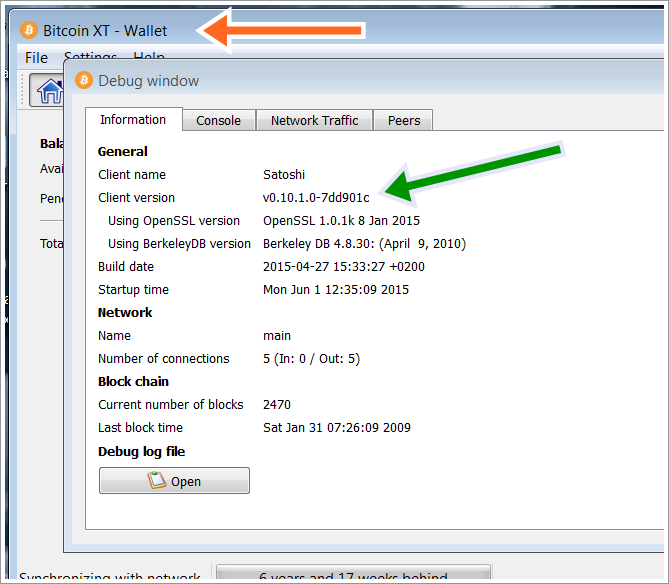Bitcoin XT: Difference between revisions
added section on controversy |
No edit summary |
||
| Line 3: | Line 3: | ||
|author=[[Gavin Andresen]]<br/>[[Mike Hearn]] | |author=[[Gavin Andresen]]<br/>[[Mike Hearn]] | ||
|website=[https://bitcoinxt.software bitcoinxt.software] | |website=[https://bitcoinxt.software bitcoinxt.software] | ||
}}'''Bitcoin XT''' | }}'''Bitcoin XT''' was a fork of [[Bitcoin Core]] created by [[Gavin Andresen]] in 2012. Originally designed to introduce alternative P2P rules,{{citation needed}} it later gained significant notoriety and support after its early adoption of [[BIP 0101|BIP 101]] in 2015, giving it importance in the [[block size limit controversy]].<ref name="ooc">{{cite web|work=[[The Neighbourhood Pool Watch]]|author=[[organofcorti]]|title=BIP101 implementation flaws|date=27 August 2015|accessdate=27 August 2015|url=http://organofcorti.blogspot.com/2015/08/bip101-implementation-flaws.html}}</ref> After Andresen's resignation from the position of [[Bitcoin Core]] maintainer, he and [[Mike Hearn]] organized Bitcoin XT to address several controversial ideas lacking the consensus required to be implemented in Bitcoin Core.<ref>{{cite web|work=Medium|title=An XT FAQ|author=[[Mike Hearn|Hearn, Mike]]|date=27 August 2015|accessdate=27 August 2015|url=https://medium.com/@octskyward/an-xt-faq-38e78aa32ff0}}</ref> | ||
BIP 101 was implemented in Bitcoin XT on August 6, 2015<ref>[https://github.com/bitcoinxt/bitcoinxt/commit/946e3ba8c7806a66c2b834d3817ff0c986c0811b]</ref> and released on August 15.<ref>{{cite web|url=https://medium.com/@octskyward/why-is-bitcoin-forking-d647312d22c1|title=Why is Bitcoin forking? — Faith and future|author=Mike Hearn|work=Medium}}</ref> If 75% of the last 1000 blocks were observed to have particular version bits set, it would have ceased enforcing the 1 MB block size limit and also have added a few new rules. However, this threshold was never achieved and no new XT blocks are being created today.{{citation needed}} | |||
In January 2016, BIP 101 was removed from Bitcoin XT and replaced with the one-time block size increase to 2 MB present in [[Bitcoin Classic]].<ref>https://github.com/bitcoinxt/bitcoinxt/pull/117</ref> In the year following this change, adoption of Bitcoin XT decreased dramatically, with fewer than 30 nodes remaining by January 2017.<ref name="cdns">{{cite web |url=https://coin.dance/nodes/xt |title=Bitcoin XT Nodes Summary |work=coin.dance |accessdate=7 January 2017 }}</ref> Later attempts by other codebases to increase the block size to 2 MB including Bitcoin Classic and [[SegWit2x]] have also failed.<ref name="cd">{{cite web|url=https://www.coindesk.com/no-fork-no-fire-segwit2x-nodes-stall-running-abandoned-bitcoin-code/|title=No Fork, No Fire: Segwit2x Nodes Stall Running Abandoned Bitcoin Code|work=[[CoinDesk]]|author=Higgins, Stan|date=November 17, 2017|accessdate=November 29, 2017}}</ref> | |||
< | |||
= | |||
==Miners== | ==Miners== | ||
| Line 52: | Line 30: | ||
[[Category:Block size limit controversy]] | [[Category:Block size limit controversy]] | ||
[[Category:Direct code forks of Bitcoin Core]] | [[Category:Direct code forks of Bitcoin Core]] | ||
[[Category:Failed hardforks]] | |||
[[Category:Contentious hardforks]] | |||
[[Category:User Interfaces]] | [[Category:User Interfaces]] | ||
[[Category:Frontends]] | [[Category:Frontends]] | ||
[[Category:Free Software]] | [[Category:Free Software]] | ||
[[Category:Open Source]] | [[Category:Open Source]] | ||
Revision as of 23:17, 4 December 2017
Bitcoin XT was a fork of Bitcoin Core created by Gavin Andresen in 2012. Originally designed to introduce alternative P2P rules,[citation needed] it later gained significant notoriety and support after its early adoption of BIP 101 in 2015, giving it importance in the block size limit controversy.[1] After Andresen's resignation from the position of Bitcoin Core maintainer, he and Mike Hearn organized Bitcoin XT to address several controversial ideas lacking the consensus required to be implemented in Bitcoin Core.[2]
BIP 101 was implemented in Bitcoin XT on August 6, 2015[3] and released on August 15.[4] If 75% of the last 1000 blocks were observed to have particular version bits set, it would have ceased enforcing the 1 MB block size limit and also have added a few new rules. However, this threshold was never achieved and no new XT blocks are being created today.[citation needed]
In January 2016, BIP 101 was removed from Bitcoin XT and replaced with the one-time block size increase to 2 MB present in Bitcoin Classic.[5] In the year following this change, adoption of Bitcoin XT decreased dramatically, with fewer than 30 nodes remaining by January 2017.[6] Later attempts by other codebases to increase the block size to 2 MB including Bitcoin Classic and SegWit2x have also failed.[7]
Miners
Miners that side with Bitcoin XT will produce blocks with a new version number.[8] This indicates to the rest of the network that they support XT.[8] When 75% of the last 1000 blocks are new-version blocks, these miners will automatically abandon Bitcoin and begin mining on a new Bitcoin XT blockchain.[8] This will begin after a waiting period of two weeks in hopes the economy in this time may force anyone who hasn't switched yet to do so.[8]
Users and miners running full Bitcoin nodes will reject the XT blockchain starting with the first block that is larger than one megabyte in size, and thus be unaffected provided it fails to achieve economic consensus.
Users and merchants
If insufficient mining hash power runs XT to reach supermajority then nothing will happen. If enough does, XT users will follow a new blockchain and cease to be using and trading bitcoins.
Controversy
Later in January 2016, frustrated of his proposal being massively outvoted, Mike Hearn made a media stunt declaring on various US national and international press agencies that "Bitcoin has failed". Max Keiser defined this episode a "whining ragequit" (beginning of E855 on RT) and other members of the community pointed to an extensive account of manipulations http://gettopical.com/bitcoin/e289a9a5189008d994e80666e9038089 (unfortunately today many twitter screenshots are broken).
See Also
References
- ↑ organofcorti (27 August 2015). "BIP101 implementation flaws". The Neighbourhood Pool Watch. http://organofcorti.blogspot.com/2015/08/bip101-implementation-flaws.html. Retrieved 27 August 2015.
- ↑ Hearn, Mike (27 August 2015). "An XT FAQ". Medium. https://medium.com/@octskyward/an-xt-faq-38e78aa32ff0. Retrieved 27 August 2015.
- ↑ [1]
- ↑ Mike Hearn. "Why is Bitcoin forking? — Faith and future". Medium. https://medium.com/@octskyward/why-is-bitcoin-forking-d647312d22c1.
- ↑ https://github.com/bitcoinxt/bitcoinxt/pull/117
- ↑ "Bitcoin XT Nodes Summary". coin.dance. https://coin.dance/nodes/xt. Retrieved 7 January 2017.
- ↑ Higgins, Stan (November 17, 2017). "No Fork, No Fire: Segwit2x Nodes Stall Running Abandoned Bitcoin Code". CoinDesk. https://www.coindesk.com/no-fork-no-fire-segwit2x-nodes-stall-running-abandoned-bitcoin-code/. Retrieved November 29, 2017.
- ↑ 8.0 8.1 8.2 8.3 Wilson, Fred (17 August 2015). "The Bitcoin XT Fork". AVC. http://avc.com/2015/08/the-bitcoin-xt-fork/. Retrieved 28 August 2015.

